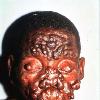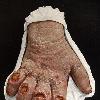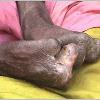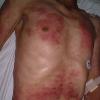Adjusted contrast and exposure. Tags: Leprosy View |
Topics: Health Tags: Leprosy View |
The oldest known skeleton showing signs of leprosy has been found in India and may help solve the puzzle of where the disease originated Tags: Leprosy View |
|||||||||
Leprosy 6 Tags: Leprosy View |
Symptoms of Leprosy The most common symptoms of leprosy are Symptoms of Leprosy 1 Tags: Leprosy View |
Tags: Leprosy Pictures, Leprosy View |
|||||||||
Leprosy or Hansens disease (HD), named after physician Gerhard Armauer Hansen is a chronic (Chronic (medical)) disease caused by the bacteria Mycobacterium leprae and Mycobacterium lepromatosis.cite journal author=Sasaki S, Takeshita F, Okuda K, Ishii N title=Mycobacterium leprae and leprosy: a compendium journal=Microbiol Immunol volume=45 issue=11 pages=729-36 year=2001 url = pmid=11791665 Leprosy is primarily a granulomatous disease of the peripheral nerves (Peripheral nervous system) and mucosa (Mucous membrane) of the upper respiratory tract; skin lesions are the primary external sign. Left untreated, leprosy can be progressive, causing permanent damage to the skin, nerves, limbs and eyes. Contrary to folklore, leprosy does not cause body parts to fall off, although they can become numb and/or diseased as a result of the disease.
Leprosy has affected humanity for over 4,000 years, and was well-recognized in the civilizations of ancient China (History of China), Egypt (ancient Egypt), and India (History of India).cite web title = Leprosy work = WHO url = date=2009-08-01 accessdate = 2010-01-31 DNA taken from the shrouded remains of a man discovered in a tomb next to the Old City of Jerusalem shows him to be the first human proven to have suffered from leprosy. In 1995, the World Health Organization (WHO) estimated that between 2 and 3 million people were permanently disabled because of leprosy.cite journal author=WHOtitle=Leprosy disabilities: magnitude of the problem journal=Weekly Epidemiological Record volume=70 issue=38 pages=269-75 year=1995 pmid=7577430 In the past 20 years, 15 million people worldwide have been cured of leprosy. Although the forced quarantine or segregation of patients is unnecessary in places where adequate treatments are available, many leper colonies (leper colony) still remain around the world in countries such as India (where there are still more than 1,000 leper colonies), China, Romania, Egypt, Nepal, Somalia, Liberia, Vietnam, and Japan (National Hansens Disease Museum (Japan)). Leprosy was once believed to be highly contagious and sexually transmitted, and was treated with mercury (Mercury (element))?all of which applied to syphilis which was first described in 1530. It is now thought that many early cases of leprosy could have been syphilis. Leprosy is now known to be neither sexually transmitted nor highly infectious after treatment, as approximately 95% of people are naturally immune and sufferers are no longer infectious after as little as 2 weeks of treatment. Before treatment was developed, leprosy was certainly contagious.
The age-old social stigma, in other words, leprosy stigma associated with the advanced form of leprosy lingers in many areas, and remains a major obstacle to self-reporting and early treatment. Effective treatment for leprosy appeared in the late 1930s with the introduction of dapsone and its derivatives. Leprosy bacilli (Bacillus (shape)) resistant to dapsone soon evolved (Antibiotic resistance) and, due to overuse of dapsone, became widespread. It was not until the introduction of multidrug therapy (MDT) in the early 1980s that the disease could be diagnosed and treated successfully within the community.
MDT for multibacillary leprosy consists of rifampicin, dapsone, and clofazimine taken over 12 months. Dosages adjusted appropriately for children and adults are available in all Primary Health Centres in the form of blister packages. Single dose MDT for single lesion leprosy consists of rifampicin, ofloxacin, and minocycline. The move towards single dose treatment strategies has reduced the prevalence of disease in some regions since prevalence is dependent on duration of treatment.
World Leprosy Day was created to draw awareness to leprosy and its sufferers.
Icd10: ICD10A30 a30
Icd9: ICD9030
Icdo: xxxxx DiseasesDB = 8478
Omim: 246300
Medlineplus: 001347
Emedicinesubj: med
Emedicinetopic: 1281
Emedicine Mult: eMedicine2derm223 eMedicine2neuro187
Meshname: Leprosy
Number on List: C01.252.410.040.552.386








